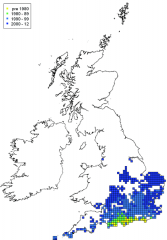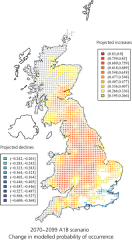Climate Change Ecology
Biological records represent an essential resource to document and understand the impacts of climate change on biodiversity. High quality data has enabled the UK to be at the forefront of climate change research. Internationally important publications have also been produced directly from the data provided by volunteer schemes and societies. Current projects using biological recording data include assessing the risks and opportunities faced by individual species during climatic changes and identifying refugia which may help promote the persistence of species.
Analyses of distribution data provided some of the first demonstrations of the impacts of climate change on biodiversity. Climate warming has caused many species to shift their distributions, with their responses often influenced by land use changes. Biological recording has been invaluable in understanding these interacting effects, predicting the risks and opportunities faced by species from climate change and identifying appropriate ‘adaptation actions’ to reduce undesired climate change impacts.
General patterns of northward range shift across many different taxonomic groups
Figure: S. Mason, CEH
Based on distribution data from 1960-2002, most animal groups have shown an average northward shift in their British range margin, albeit with substantial variation within groups. Bars show results for hectads where 10% of the species in a group were recorded in both time periods; similar results were obtained with other cut-off values.
Projected distribution change for an example species, Bombus ruderarius, the red-shanked carder bee
Figure: Tom Oliver, CEH
Bioclimate models relate observed occurrences to various climatic variables to produce a modelled ‘climatic suitability’ surface for a species. This map shows changes relative to the historic baseline where new climate space is shown as yellow and red, white squares showing areas of climate overlap, blue squares showing adversely sensitive areas and grey squares indicate areas climatically unsuitable in both periods.
A challenge is to explain the different responses of species with similar initial ranges to climate change. We continue to improve models to predict future changes, taking into account species ecology and patterns of recording. The substantial effort of volunteers in providing the geographic and taxonomic coverage of biological records is invaluable to increasing our understanding of the impacts of climate change. Ultimately, the development of robust evidence-based adaptation and conservation strategies is highly reliant on this unique data resource.


